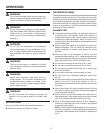
18
OPERATION
on
Fig. 10
SwitCh key
oFF
AVOIDING SNIPE
Snipes, or depressions made at either end of a workpiece
by cutter blades, can occur when the board is not properly
supported. Although snipe may be barely noticeable, it is
important to keep the workpiece parallel and flat with the
planer table to minimize snipe. Butting workpieces end-
to-end as they are fed through the planer will minimize the
problem, especially for shorter pieces, because it provides
a more stable feed.
For workpieces longer than 48 in., greater care must be
taken to reduce the problem because the additional length
means more of the total weight is unsupported by the planer
table and rollers, causing the shifting weight to work against
keeping the stock flat.
To remove snipe from a finished workpiece, cut off the end
of the workpiece where snipe is noticeable.
WARPED WOOD
Little or no warpage is the ideal condition for planing a
workpiece. Simply turn the workpiece over and plane it to
the desired thickness. Otherwise, plane the top first, turn
the workpiece and plane the bottom.
For a board that is cupped or bowed across its width, the best
method is to rip the board lengthwise down the middle and
plane the pieces separately. This method eliminates much
of the waste in planing cupped or bowed workpieces.
The only way to remove the bow from a workpiece that is
cupped or bowed down its length is to use a jointer.
Avoid using severely warped wood as it can jam the planer.
If it must be used, rip it in half before planing to help mini-
mize the possibility of jamming. If jamming does occur, turn
the switch off and unplug the planer immediately. Raise the
cutterhead assembly high enough to remove the workpiece
easily. Carefully check to make sure no damage to the tool
has occurred before making the next planing pass.
Always feed the workpiece in the direction of the grain. This
allows the cutter blades to sever the wood fibers instead of
tearing them. Feeding against the grain can also cause the
cutter blades to chip the workpiece.
POWER SWITCH
See Figure 10.
The planer is equipped with a power switch that has a built-in
locking feature. This feature is intended to prevent unauthor-
ized and possible hazardous use by children and others.
TO TURN THE PLANER ON:
With the switch key inserted into the switch, lift the switch
to turn ON ( l ).
TO TURN THE PLANER OFF:
With the switch key inserted into the switch, push the
switch down to turn OFF ( O ).
TO LOCK THE PLANER:
Place the switch in the OFF ( O ) position.
Remove the switch key from the switch and store in a
secure location.
WARNING:
Always remove the switch key when the tool is
not in use and keep it in a safe place. In the event
of a power failure, turn the switch OFF ( O ) and
remove the key. This action will prevent the tool
from accidentally starting when power returns.
WARNING:
Always make sure the workpiece is not in contact
with the blade before operating the switch to start
the tool. Failure to heed this warning may cause the
workpiece to be kicked back toward the operator
and result in serious personal injury.


















